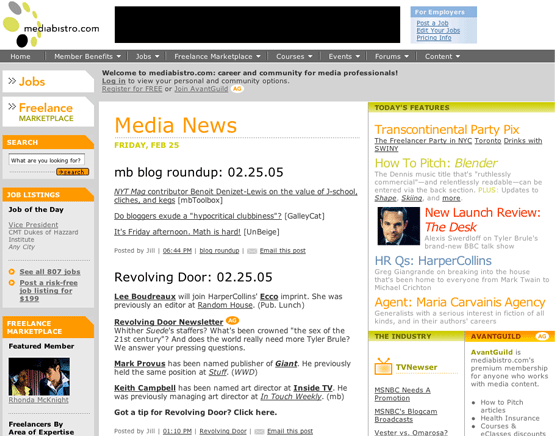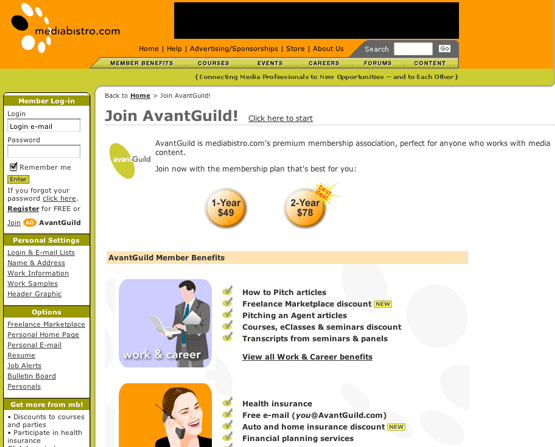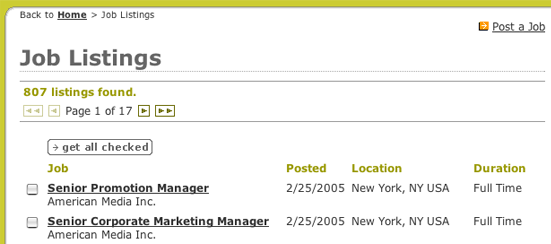Background
Laurel Touby started MediaBistro in 1997 in the dot-com heyday with the goal of creating a community for journalists. “We weren’t really sure how we were going to make money,” she confesses, “we just wanted to bring media people together.” While this may not sound like an auspicious mission for a profitable business, MediaBistro has developed some very profitable income streams, all of which flow from this community, and all of which provide content models easily adopted by traditional publishers.
One of the first initiatives the fledgling New York-based MediaBistro mounted was organizing no-host, after-work parties for journalists at local watering holes. It posted invitations on its website and waited to see if anyone would show. “As I look back on it,” jokes Touby, “I organized these parties mostly because I wanted to meet boys.” (Several years later, Touby married a journalist she met not at one of MediaBistro’s parties, but at a journalism convention.)

Today, MediaBistro organizes its media parties in major cities around the U.S. and in key international cities, but that’s not how they make money. The business derives its revenues from three sources: paid advertising listings, continuing education classes and memberships in AvantGuild, a “media club” that provides benefits to members.
Obviously, each of these services is fed by MediaBistro’s community-building efforts—Touby (pronounced toe-be) claims to have more than 300,000 people registered at the site. The company’s homepage features a daily feed of news content about the media, and the company recently hired Elizabeth Spier, founder of the NY gossip blog, Gawker, as editor in chief. (We’re talking celebrity journalism here, and the company has received a heap of media buzz about it, especially considering annual sales that Touby admits are less than $3 million.)
Appropriate to its roots and image, MediaBistro’s tagline is “jobs, parties, people,” and Touby lists herself as “founder and cyberhostess.”
MediaBistro Mixes Website Models Better Than Most
When you deconstruct the MediaBistro model, you see no revenue sources that most publishers couldn’t replicate. The company provides free news on its site (could be a Mequoda Editorial Website Hub), and it provides paid information in two forms: continuing education classes in major U.S. cities (Mequoda Retail Website Satellite) and AvantGuild-only access to premium articles on subjects like “how to pitch freelanced articles to Men’s Journal” (Mequoda Membership Website Satellite). MediaBistro also sells advertising—help-wanted ads and listings in an online freelance writer directory (Mequoda Classified Website Satellite).
AvantGuild (Mequoda Membership Satellite)
MediaBistro’s AvantGuild income stream is also nothing arcane. The Guild is essentially a $49-per-year association. In addition to discounts on MediaBistro events and free access to its library of “how to pitch” articles, AG members can get free email, access to healthcare insurance and discounts on rental cars, subscriptions and tax services. As anyone who belongs to an association knows, these latter “benefits” are generally minimal in cost to the association and relatively easy to set up.

MediaBistro.com’s AvantGuild
Courses & Events (Mequoda Retail Satellite)
While most publishers probably haven’t thought about starting a series of adult education classes around the country (which is essentially what MediaBistro provides) there’s certainly nothing magical about this form of “live” information. Most publishers have held conferences before—and what is a three-hour class in Boston for 30 people on a Thursday night, but a mini-conference? MediaBistro now holds more than 400 such courses a year, most in New York at its third-floor walk-up offices in Soho, but also in Los Angeles, Washington and San Francisco, and recently, online. A three-hour course on copyediting costs just $65 ($50 for AvantGuild members), and the eight-week (24 hours total) course on Short Fiction Writing lists at $499.

MediaBistro.com’s Courses and Events

Job Listings (Mequoda Classified Satellite)
MediaBistro’s largest source of revenue is its media job listings, access to which is free to registered visitors. The site currently features some 750 job openings, which cost employers $199 each to list for 30 days. (Satisfaction is guaranteed—if you aren’t happy with the response you get, you don’t have to pay for it.) Do the math: Bistro’s job listing operation has got to be pulling down more than $1.5 million a year. The whole listing and payment process is automated, so expenses, aside from developing and maintaining the job listing function, have got to be minimal.

MediaBistro.com’s Job Listings
Why, and how, they could build a Mequoda Website Network
After reading my original profile of MediaBistro and analyzing the site himself, Mequoda Library editor Don Nicholas, noted that MediaBistro might be better served if they untangled the MediaBistro site and built a Mequoda Website Network.
A Mequoda Website Network is simply a group of related sites that serves a specific audience with a variety of information and retail services. Each website would be designed to be easy to use. Because MediaBistro serves a specific audience and offers a variety of information and retail services, the fact that they have it all bundled into one website may be confusing to some and quite frankly, hindering the potential of their bottom line.
Creating a Mequoda Website Network begins with visualizing a pyramid. Remember, the product price pyramid is divided by price points. The bottom level is always free, and the subsequent levels move up according to price of product.
At the base of the pyramid lies the Mequoda Editorial Website Hub, or what could be the current Media News portion of MediaBistro. Here, they could require free registration to view the basic news articles and offer free newsletter subscriptions. By gathering email addresses, they could eventually monetize this free relationship by moving registered users up the pyramid into paid services.
Next on the pyramid would be the MediaBistro Freelance Marketplace, a Mequoda Classified Website Satellite. The Freelance Marketplace is a forum for freelancers to showcase their work. It also acts as a place for editors and other media managers to find quality talent. Freelancers pay $19 a month or $175 a year to post on the Freelance Marketplace forum. While probably not a huge moneymaker for MediaBistro, it nonetheless offers MediaBistro users a way to sample their services at a relatively low price point.
Next on the pyramid would be the MediaBistro Events, which would serve as a Mequoda Retail Website Satellite. Here, users could purchase some of the lower priced events, which start at $19.
Then would come the Mequoda Membership Website Satellite, or MediaBistro’s AdvantGuild. As mentioned earlier, members pay $49 a year for access to particular types of articles and enjoy discounts on various related services.
The next level of the pyramid would be MediaBistro courses, which would be another Mequoda Retail Website. As mentioned earlier, one-day courses could be as little as $65 or as much as $499.
Sitting on the top of the MediaBistro Network would be their Job Listings. While free for all to view, the Job Listings section is monetized by the employers who post the jobs. Employers pay $199 to post a job for 30 days. Currently, they’re posting almost 800 jobs. As I requested earlier, do the math. This is the primary revenue source for MediaBistro, which is why it sits on the top of the pyramid.
What made Nicholas come to this conclusion is that currently on the MediaBistro site, the navigation changes depending on which portion of the site you are visiting, but the nameplate and URL don’t change significantly. This may confuse some users. Nicholas has found through his extensive research and testing over the past decade that simpler websites with less functionality end up being more pleasant to the user, and therefore more financially successful for the website publisher. By splitting up their revenue sources into their own website, MediaBistro would provide simpler navigation and potentially happier users.

This would be what MediaBistro’s Marketing pyramid would look like,
if they separated all their products and services by price point.
Conclusion
While no single revenue source in the MediaBistro mix will appear daunting to veteran information providers, most publishers will find it difficult to duplicate the powerful cachet the company has built among journalists and freelancers. When asked whether Bistro’s substantial party-throwing machinery was booked fundamentally as a public relations expense, Touby replied bemused, “Public relations? I hadn’t thought of it that way. Building this community is just what we do—it’s why we got started in the first place.”
All in all, MediaBistro is an impressive accomplishment—one that blends the best of Internet community-building techniques with some creative wrinkles on traditional specialized information publishing. Most publishers should be able to pick up a tip or two—and a healthy revenue bump—from studying Bistro’s example.


